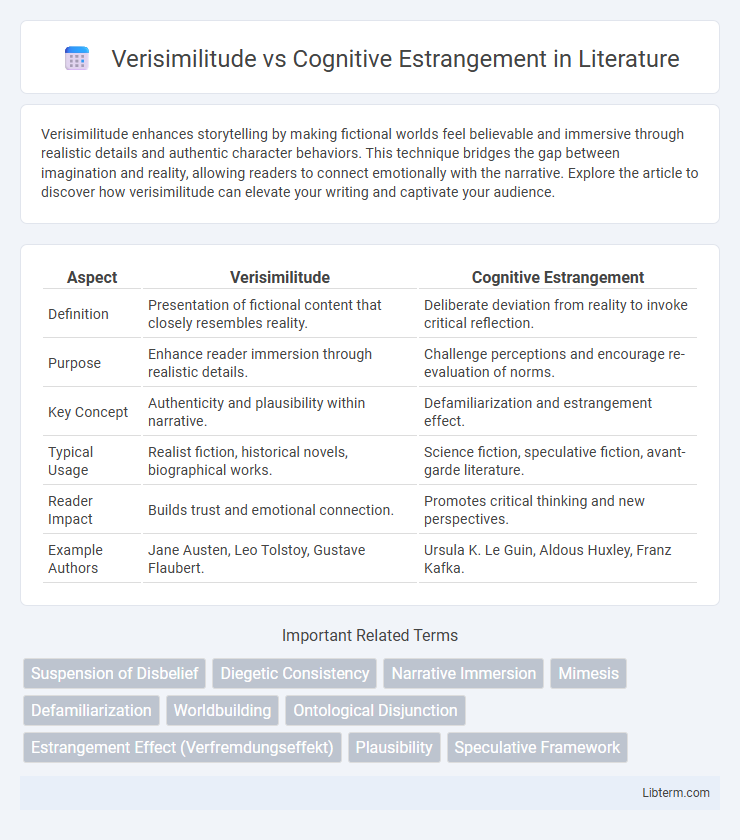Verisimilitude enhances storytelling by making fictional worlds feel believable and immersive through realistic details and authentic character behaviors. This technique bridges the gap between imagination and reality, allowing readers to connect emotionally with the narrative. Explore the article to discover how verisimilitude can elevate your writing and captivate your audience.
Table of Comparison
| Aspect | Verisimilitude | Cognitive Estrangement |
|---|---|---|
| Definition | Presentation of fictional content that closely resembles reality. | Deliberate deviation from reality to invoke critical reflection. |
| Purpose | Enhance reader immersion through realistic details. | Challenge perceptions and encourage re-evaluation of norms. |
| Key Concept | Authenticity and plausibility within narrative. | Defamiliarization and estrangement effect. |
| Typical Usage | Realist fiction, historical novels, biographical works. | Science fiction, speculative fiction, avant-garde literature. |
| Reader Impact | Builds trust and emotional connection. | Promotes critical thinking and new perspectives. |
| Example Authors | Jane Austen, Leo Tolstoy, Gustave Flaubert. | Ursula K. Le Guin, Aldous Huxley, Franz Kafka. |
Defining Verisimilitude: Reality in Fiction
Verisimilitude in fiction refers to the degree to which a narrative convincingly imitates reality, creating a sense of authenticity and believability within the story world. It relies on consistent internal logic, relatable characters, and plausible events that align with readers' understanding of the natural or social world. This concept contrasts with cognitive estrangement, which deliberately disrupts familiar reality to provoke critical reflection.
Understanding Cognitive Estrangement in Literature
Cognitive estrangement in literature refers to the technique of presenting familiar elements within unfamiliar or speculative contexts to provoke critical thinking and challenge readers' perceptions. This concept, rooted in science fiction and speculative genres, contrasts with verisimilitude, which emphasizes realism and authenticity. Cognitive estrangement encourages readers to question societal norms and explore alternative realities, fostering reflection on contemporary issues through imaginative narratives.
Historical Origins of Both Concepts
Verisimilitude originated in classical Greek literature, emphasizing the appearance of truth to create believable narratives aligned with Aristotelian poetics, while cognitive estrangement was developed in the 20th century by literary theorist Darko Suvin to describe science fiction's method of defamiliarizing reality through conceptual innovation. Verisimilitude grounds a story in recognizable reality by adhering to logical consistency and familiar conventions, whereas cognitive estrangement intentionally disrupts reality to provoke critical reflection by introducing unfamiliar elements within a coherent framework. The historical foundations of verisimilitude trace back to Aristotle's *Poetics*, contrasting with cognitive estrangement's roots in modern critical theory and genre studies, highlighting divergent approaches to audience perception and engagement.
Key Differences Between Verisimilitude and Cognitive Estrangement
Verisimilitude emphasizes creating a believable and internally consistent world that mirrors reality, ensuring readers can relate to the narrative through familiar settings, characters, and events. Cognitive estrangement intentionally disrupts the reader's perception by introducing unfamiliar or speculative elements that challenge accepted truths, prompting critical reflection on reality. The key difference lies in verisimilitude's goal of immersion through realism, whereas cognitive estrangement seeks to defamiliarize the ordinary, fostering analytical distance.
The Role in Science Fiction and Fantasy Genres
Verisimilitude in science fiction and fantasy establishes a believable world through internal consistency and adherence to recognizable laws, enabling readers to immerse in the narrative. Cognitive estrangement, a concept coined by Darko Suvin, intentionally distorts reality to challenge readers' perceptions and provoke critical thinking about societal norms. Both mechanisms serve crucial roles by balancing familiarity with innovation to enrich speculative storytelling and deepen reader engagement.
Impact on Reader Perception and Engagement
Verisimilitude enhances reader perception by creating a believable and consistent fictional world that mirrors real-life logic, fostering deeper emotional engagement and immersion. Cognitive estrangement, by introducing unfamiliar or speculative elements, challenges readers to question reality and encourages critical thinking, often resulting in heightened intellectual engagement rather than emotional attachment. The contrasting impacts shape how readers interact with the narrative, either through empathetic immersion or analytical distance.
Examples of Verisimilitude in Classic Literature
In classic literature, verisimilitude is exemplified by detailed realism in works like Charles Dickens' "Great Expectations," where authentic social settings and character behavior mirror 19th-century England. Similarly, Jane Austen's novels such as "Pride and Prejudice" use precise dialogue and societal norms to create believable narratives. These examples anchor fictional stories in recognizable reality, enhancing reader immersion through credible environments and character motivations.
Cognitive Estrangement: Notable Works and Authors
Cognitive estrangement, a key concept in speculative fiction, is prominently explored in the works of Ursula K. Le Guin and Philip K. Dick, who use altered realities to challenge readers' perceptions of normality. Le Guin's "The Left Hand of Darkness" employs cognitive estrangement to examine gender and social constructs, while Dick's "Do Androids Dream of Electric Sheep?" questions the nature of humanity and consciousness. These authors leverage cognitive estrangement to provoke critical reflection on sociopolitical and philosophical issues through imaginative narrative frameworks.
Balancing Reality and Estrangement in Narrative Craft
Balancing reality and estrangement in narrative craft involves blending verisimilitude, the appearance of truth, with cognitive estrangement, which disrupts familiar perceptions to provoke critical thought. Effective narratives maintain internal consistency and relatable details to ground the audience while introducing speculative or alien elements that challenge conventional understanding. This equilibrium fosters immersive storytelling that simultaneously comforts and unsettles, encouraging deeper engagement and reflection.
Implications for Contemporary Storytelling
Verisimilitude in contemporary storytelling fosters immersive narratives by anchoring stories in recognizable reality and relatable characters, enhancing audience empathy and suspension of disbelief. Cognitive estrangement challenges viewers by presenting unfamiliar or speculative worlds that prompt critical reflection on societal norms and encourage imaginative thinking. The interplay between verisimilitude and cognitive estrangement enables creators to balance realism with innovation, expanding the boundaries of genre storytelling and audience engagement.
Verisimilitude Infographic

 libterm.com
libterm.com